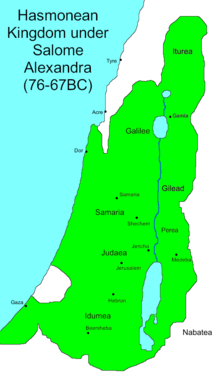Salome Alexandra Click here.
https://en.m.wikipedia.org/wiki/Salome_Alexandra
Salome Alexandra
Salome Alexandra or Alexandra of Jerusalem (Hebrew: שְׁלוֹמְצִיּוֹן אלכסנדרה, Shelomtzion or Shlom Tzion; 141–67 BCE),[1] was one of only two women to rule over Judea (the other being Athaliah). The wife of Aristobulus I, and afterward of Alexander Jannaeus,[2] she was the last queen of Judea, and the last ruler of ancient Judea to die as the ruler of an independent kingdom from 76 to 67 BCE.
Family
Salome Alexandra's personal genealogy is not given by Josephus. Rabbinical sources designate the sage, Simeon ben Shetah, as her brother,[3] making her the daughter of Shetah Bar Yossei. Salome Alexandra's oldest son by Alexander Jannaeus was Hyrcanus II who fought his younger brother Aristobulus II in 73 BCE over the Jewish High Priesthood.[4] Hyrcanus II was eventually successful after enlisting the help of the Nabataean king, Aretas III; bribing Roman officials, including Scaurus; and gaining the favour of Pompey the Great, who defeated his brother and took him away to Rome.[5]
Consort
According to the Jewish Encyclopedia, Salome Alexandra was instrumental in arranging the assassination of her brother-in-law, Antigonus, by convincing her husband that his brother was plotting against him.[6] Upon the death of Aristobulus in 103 BCE, Aristobulus' widow freed his half-brother, Alexander Jannaeus, who had been held in prison.
During the reign of Alexander, who (according to the historian Josephus) apparently married her shortly after his accession,[7] Alexandra seemed to have wielded only slight political influence, as evidenced by the hostile attitude of the king to the Pharisees.
Political ability
The frequent visits to the palace of the chief of the Pharisaic party, Simeon ben Shetach, who was said to be the queen's brother, must have occurred in the early years of Alexander's reign, before Alexander had openly broken with the Pharisees. Alexandra does not seem to have been able to prevent the persecution of that sect by her husband.
According to archaeologist Kenneth Atkinson, "There are also some passages in the Talmud that say, during her husband's reign, that she protected Pharisees and hid Pharisees from his wrath."[8] Nevertheless, the married life of the royal pair seems to have ended cordially; on his deathbed Alexander entrusted the government, not to his sons, but to his wife, with the advice to make peace with the Pharisees.[9]
Salome Alexandra's next concern was to open negotiations with the leaders of the Pharisees, whose places of concealment she knew. Having been given assurances as to her future policy, they declared themselves ready to give Alexander's remains the obsequies due to a monarch. By this step she avoided any public affront to the dead king, which, owing to the embitterment of the people, would certainly have found expression at the interment. This might have been attended with dangerous results for the Hasmonean dynasty.
Regent
Salome Alexandra received the reins of government (76 or 75 BCE) at Jannaeus' camp before Ragaba, and concealed the king's death until the fortress had fallen, in order that the rigour of the siege might be maintained. She succeeded for a time in quietening the vexatious internal dissensions of the kingdom that existed at the time of Alexander's death; and she did this peacefully and without detriment to the political relations of the Jewish state to the outside world. Alexandra managed to secure assent to a Hasmonean monarchy from the Pharisees, who had suffered under Alexander.
Re-establishment of the Sanhedrin
The Pharisees now became not only a tolerated section of the community, but actually the ruling class. Salome Alexandra installed as high priest her eldest son, Hyrcanus II, a man who was wholly supportive of the Pharisees and the Sanhedrin was reorganized according to their wishes and became a supreme court for the administration of justice and religious matters, the guidance of which was placed in the hands of the Pharisees.
Internal and external policy
The Sadducees were moved to petition the queen for protection against the ruling party. Salome Alexandra, who desired to avoid all party conflict, removed the Sadducees from Jerusalem, assigning certain fortified towns for their residence.
Salome Alexandra increased the size of the army and carefully provisioned the numerous fortified places so that neighbouring monarchs were duly impressed by the number of protected towns and castles which bordered the Judean frontier. As well, she did not abstain from actual warfare; she sent her son Aristobulus with an army to besiege Damascus, then beleaguered by Ptolemy Menneus. The expedition reportedly achieved little.
The last days of Salome Alexandra's reign were tumultuous. Her son, Aristobulus, endeavoured to seize the government, and succeeded her after her death.
Prosperity
Rabbinical sources refer in glowing terms to the prosperity which Judea enjoyed under Salome Alexandra. The Haggadah (Ta'anit, 23a; Sifra, ḤuḲḲat, i. 110) relates that during her rule, as a reward for her piety, rain fell only on Sabbath (Friday) nights; so that the working class suffered no loss of pay through the rain falling during their work-time. The fertility of the soil was so great that the grains of wheat grew as large as kidney beans; oats as large as olives; and lentils as large as gold denarii. The sages collected specimens of these grains and preserved them to show future generations the rewards of obedience to the Law, and what piety could achieve.[10]
Name
"Shlomtzion" (Hebrew: שלומציון), derived from the queen's name, is sometimes used as a female first name in contemporary Israel. Among others, the well-known Israeli writer Amos Kenan bestowed that name on his daughter.
In the 1977 Knesset elections Ariel Sharon accepted the advice of Kenan to give the name "Shlomtzion" to a new political party which Sharon was forming at the time (it later merged with the Likud).
In medieval sources
According to some versions of the Toledoth Yeshu, a medieval alternative-Christian life of Jesus, Salome is connected with Jesus of Nazareth, placing the death of Jesus 150 years earlier.[11]


Comments
Post a Comment